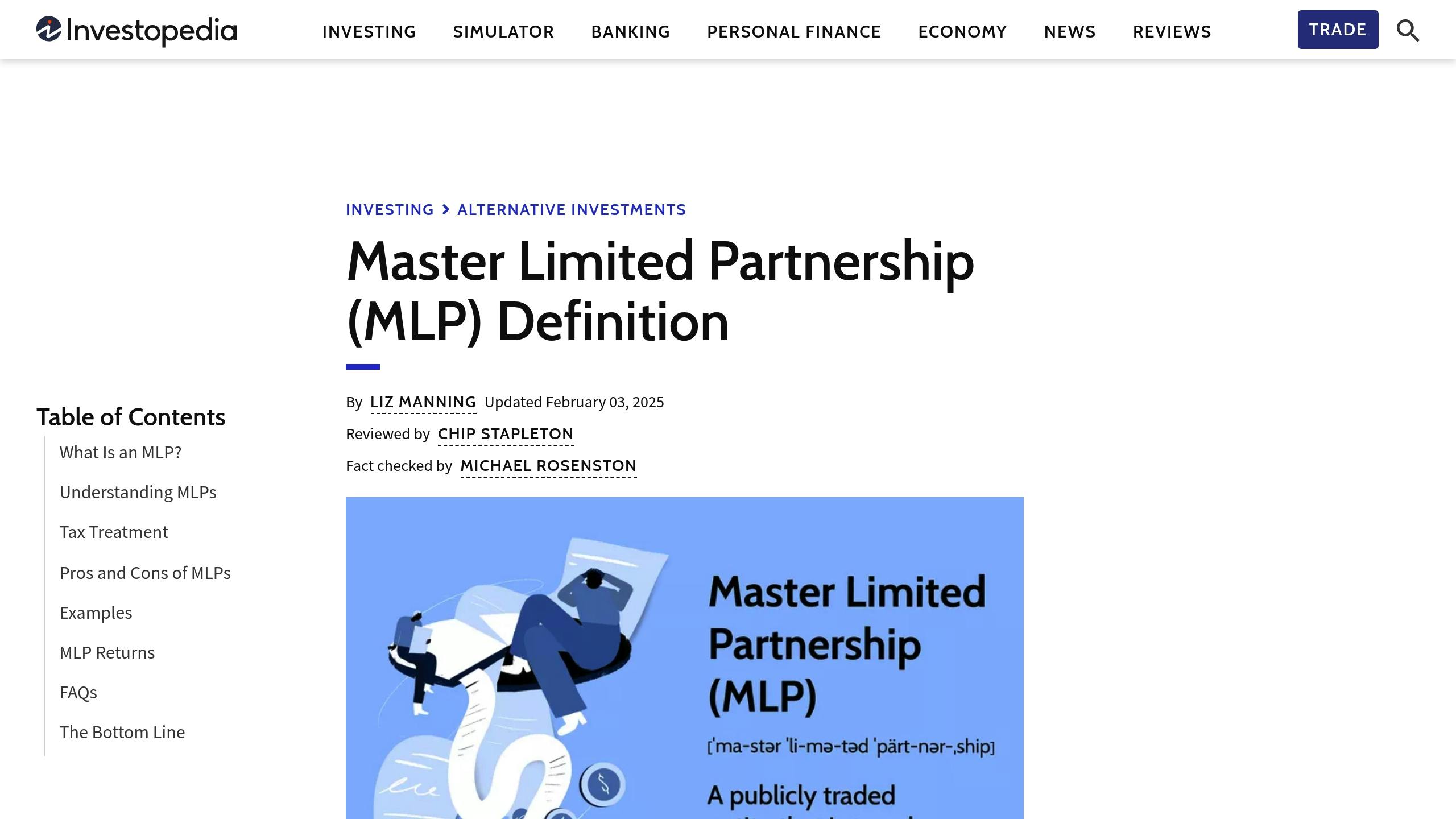Understand the tax implications of investing in MLPs, including distribution treatment, K-1 reporting, and strategies to maximize benefits.
Master Limited Partnerships (MLPs) offer unique tax benefits but come with complexities. Here's what you need to know:
- Tax-Deferred Distributions: Most MLP distributions (70–100%) are tax-deferred until you sell.
- Cost Basis Adjustments: Distributions lower your cost basis, impacting gains when you sell.
- Pass-Through Income: Income passes directly to investors, avoiding corporate taxes.
- Schedule K-1: MLPs issue K-1 forms instead of 1099s, requiring careful tax reporting.
- Selling Units: Sales trigger both capital gains and ordinary income taxes due to depreciation recapture.
- Retirement Accounts: MLPs in IRAs can cause UBTI taxes; consider MLP ETFs instead.
Quick Comparison: MLPs vs. Traditional Stocks
| Feature | MLP Units | Traditional Stocks |
|---|---|---|
| Tax on Distributions | Deferred until sale | Taxed in the year received |
| Tax Forms | Schedule K-1 | Form 1099-DIV |
| Corporate Tax | None (pass-through structure) | Subject to double taxation |
| Sale Tax Treatment | Capital gains + ordinary income | Only capital gains |
Pro Tip: Hold MLPs in taxable accounts to maximize tax benefits and avoid complications like UBTI in retirement accounts. Track your cost basis and consult a tax professional to simplify reporting.
Master Limited Partnerships Explained (MLPs)

MLP Tax Structure
Let's dive into the tax mechanics of MLPs and how they impact investors.
Pass-Through Income Benefits
MLPs avoid corporate taxes by passing their income directly to unitholders. For example, if an MLP distributes $4,000 and has $3,000 in recaptured depreciation, taxes are only owed on the $1,000 difference . This approach helps maximize after-tax income.
Now, let’s break down how these distributions affect your cost basis.
Cost Basis Changes
The cost basis of your MLP units adjusts based on the distributions you receive:
| Action | Impact on Cost Basis | Tax Impact |
|---|---|---|
| Initial Investment | Sets your starting cost basis | No immediate tax |
| Regular Distributions | Decreases cost basis | Tax-deferred until you sell |
| Zero Cost Basis | Future distributions | Taxed as capital gains |
As distributions lower your cost basis, once it hits zero, any additional distributions are treated as capital gains for tax purposes .
Let’s see how this compares to the tax treatment of traditional stocks.
MLP vs. Stock Tax Treatment
| Feature | MLP Units | Traditional Stocks |
|---|---|---|
| Distribution Tax Timing | Deferred until sale | Taxed in the year received |
| Tax Forms | Schedule K-1 | Form 1099-DIV |
| Corporate Tax Level | None | Subject to double taxation |
| Sale Tax Treatment | Capital gains and ordinary income | Only capital gains |
Selling MLP units can lead to two types of taxes: capital gains on any appreciation and ordinary income on recaptured depreciation . To handle this properly, keep detailed records of your K-1 forms, which are essential for calculating these tax components during a sale .
Schedule K-1 Reporting

Understanding how to handle distributions and cost basis changes is important, but properly reporting your K-1 form is just as crucial for staying on top of your tax responsibilities.
K-1 Form Basics
Schedule K-1 forms are tax documents issued by MLPs (Master Limited Partnerships) to detail each unitholder's share of income, losses, and distributions. Here's a quick breakdown of the key sections:
| Section | Information Reported | Tax Impact |
|---|---|---|
| Part I | Investor Details | Identifies you and the partnership |
| Part II | Partnership Income/Loss | Displays your share of profits or losses |
| Part III | Partner's Share of Items | Lists specific income types and deductions |
Common K-1 Filing Issues
Filing errors on your K-1 can lead to unnecessary headaches. Here are some common problems and how to address them:
| Problem | Impact | Recommended Action |
|---|---|---|
| Missing Self-Employment Taxes | Risk of IRS penalties | Check Part III for any self-employment income |
| Unreported Income | Penalties for underpayment | Verify all K-1 amounts are included in your tax return |
| Coding Errors | Incorrect tax treatment | Use K-1 instructions or consult a tax professional for guidance |
K-1 Filing Example
Each type of income listed on your K-1 must be reported in the correct section of your tax return. For instance, if your K-1 shows $3,000 in ordinary business income, $1,000 in qualified dividends, and $2,000 in depreciation deductions, you would report:
- Ordinary business income on Schedule E
- Dividend income on Schedule B
- Depreciation deductions in the relevant section
Keep in mind, business losses from an MLP are deferred until they can be offset by income from the same MLP .
If your K-1 arrives late - which is common with MLPs - here’s what to do:
- File for a tax extension right away.
- Contact the MLP to get estimated figures.
- Request expedited delivery of the final K-1 form .
Properly handling your K-1 helps you avoid surprises and sets you up to manage the tax implications when selling your MLP units.
Selling MLP Units: Tax Rules
Tax Recapture Rules
When you sell MLP units, tax recapture comes into play. Your taxable gain is calculated as the sale price minus your adjusted basis. Adjustments to your basis happen due to net taxable income increases and depreciation decreases. Here's a simplified breakdown:
| Component | Amount per Unit | Total (1,000 Units) | Tax Treatment |
|---|---|---|---|
| Initial Purchase | $30.00 | $30,000 | Base cost |
| Cash Distributions | -$2.50 | -$2,500 | Basis reduction |
| Net Taxable Income | +$0.50 | +$500 | Basis increase |
| Depreciation | -$1.50 | -$1,500 | Ordinary income |
| Final Sale Price | $32.00 | $32,000 | Total gain |
The total gain of $4,000 breaks down as follows:
- $1,500 taxed as ordinary income due to depreciation recapture
- $2,500 taxed at capital gains rates
Knowing how these rules work can help you make better decisions when selling.
Tax Planning for Sales
Effective tax planning can help reduce your liabilities when selling MLP units. Here are some strategies to consider:
| Strategy | Benefit | Consideration |
|---|---|---|
| Estate Planning | Heirs receive a step-up in basis | Requires long-term holding |
| Loss Harvesting | Offsets gains with losses | Only applies to full unit sales |
| Basis Tracking | Ensures accurate gain reporting | Needs detailed K-1 records |
One key point: losses from an MLP can only offset income from that same MLP until you sell all your units. This makes the timing of your sale especially important. Keep detailed records to make the most of these strategies.
Special Tax Topics
QBI Deduction Rules
The Qualified Business Income (QBI) deduction offers tax relief to investors in Master Limited Partnerships (MLPs). Since 2018, investors can claim up to a 20% deduction on qualified business income from MLPs, potentially reducing the top tax rate from 37% to 29.6% .
Here's how QBI applies to MLP investments:
| Component | Treatment | Limitations |
|---|---|---|
| MLP Income | Eligible for a 20% deduction | Subject to income thresholds |
| REIT Dividends | Eligible for a 20% deduction | No W-2 wage limitations |
| Interest Income | Not eligible | Excluded from QBI |
| Capital Gains | Not eligible | Excluded from QBI |
The deduction depends on factors like your total taxable income and specific business rules. Your K-1 form will detail your share of QBI from the partnership, which simplifies determining your eligible deduction .
Additionally, state-specific tax rules can further influence how MLPs are taxed.
State Tax Rules
Investing in MLPs often means dealing with tax obligations in multiple states. Since many MLPs operate across state lines, you may need to file tax returns in every state where the MLP earns income - even if the income allocated to you is small . The K-1 form will list state income allocations to help with these filings .
Some states have agreements to make filing easier. For example, Pennsylvania has reciprocal agreements with states like Maryland, New Jersey, and Virginia, which can reduce your tax filing requirements .
If you're considering placing MLPs in retirement accounts, additional tax considerations come into play.
MLPs in Retirement Accounts
Holding MLPs in retirement accounts, like IRAs, can trigger Unrelated Business Taxable Income (UBTI) taxes. The current UBTI tax rate is 37% on income exceeding $1,000 .
Here are a few alternatives for managing MLP exposure in retirement accounts:
| Investment Vehicle | UBTI Impact | Tax Efficiency |
|---|---|---|
| Direct MLP Holdings | May trigger UBTI | Less efficient in IRAs |
| MLP ETFs | Usually avoid UBTI | More tax-efficient for retirement accounts |
| MLP Corporation Shares | No UBTI issues | Simpler tax treatment |
Rebecca Dawson, Dawson Capital: "If a Roth IRA earns $1,000 or more of UBTI annually, the UBTI income above $1,000 is subject to tax even if the securities are held in a retirement account, which is typically not taxed" .
Most advisors suggest holding MLPs in taxable accounts to take full advantage of their tax benefits and avoid UBTI complications in retirement accounts . If you want MLP exposure in a retirement portfolio, consider MLP-focused ETFs or mutual funds designed to bypass UBTI issues.
Conclusion
Key Takeaways
Investing in MLPs requires careful tax planning. These investments come with tax benefits due to their pass-through structure, with 70–100% of distributions typically treated as tax-deferred returns of capital .
Here’s a quick breakdown of key tax factors:
| Aspect | Tax Impact | Planning Tip |
|---|---|---|
| Distributions | Tax-deferred return of capital | Lowers your cost basis |
| Income Allocation | Pass-through taxation | Reported on Schedule K-1 |
| Unit Sales | Capital gains + ordinary income | Keep track of basis adjustments |
| QBI Deduction | Up to 20% tax reduction | Subject to income thresholds |
Steps to Consider
- Track Your Basis: Keep detailed records of your investment and any basis adjustments. This is essential for calculating gains when you sell.
- Choose the Right Account: Hold MLPs in taxable accounts to retain tax deferral benefits and avoid UBTI issues. For retirement accounts, consider MLP ETFs that issue Form 1099s instead of Schedule K-1s.
"As long as your distribution is less than your basis, it is 100% tax-deferred." – MLPA
- Consult a Tax Professional: Work with a tax advisor who understands MLPs, K-1 reporting, and state tax rules to ensure compliance and maximize benefits.
- Review Distribution History: Evaluate each MLP’s past distributions and tax details to confirm they align with your financial goals and tax strategy.




